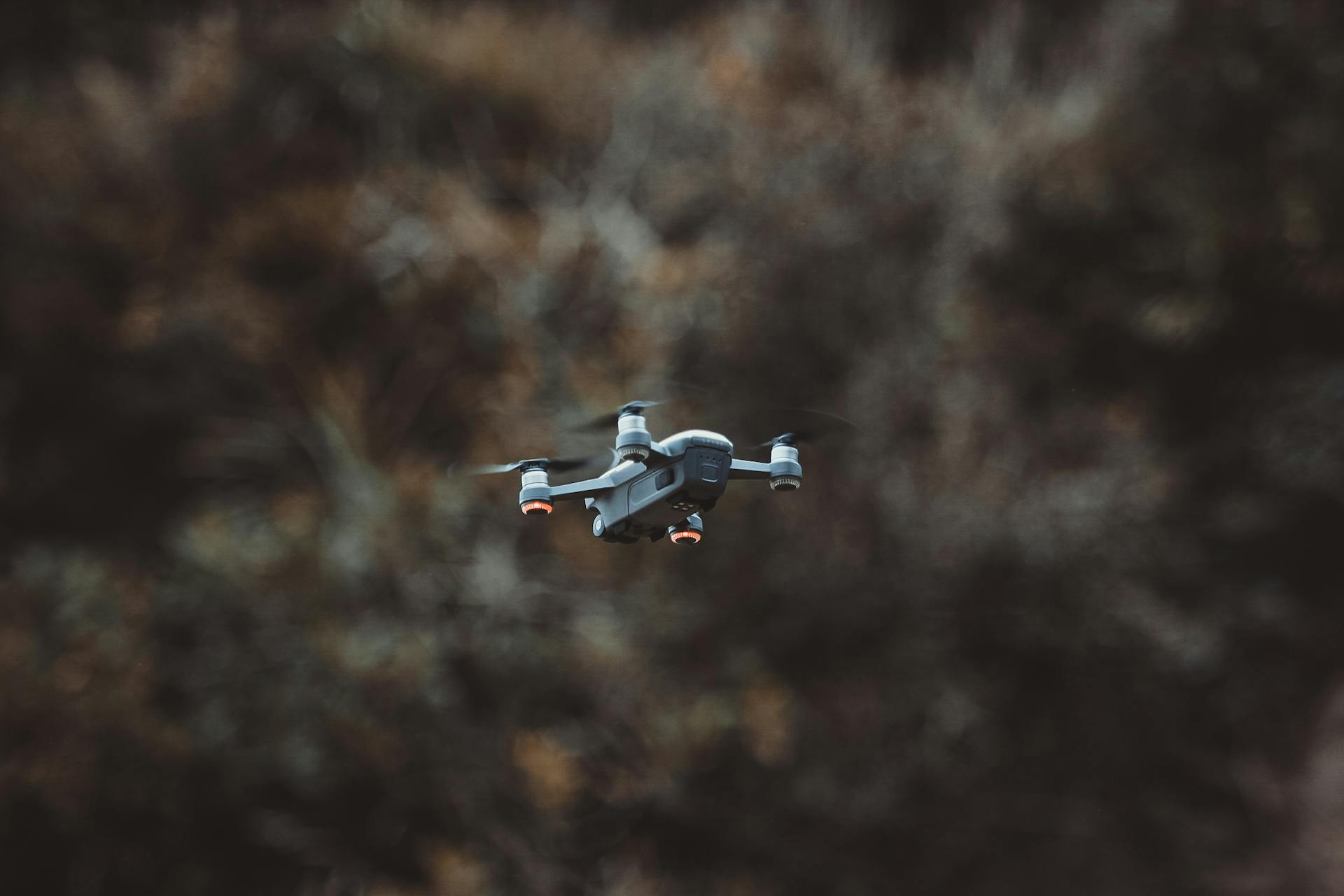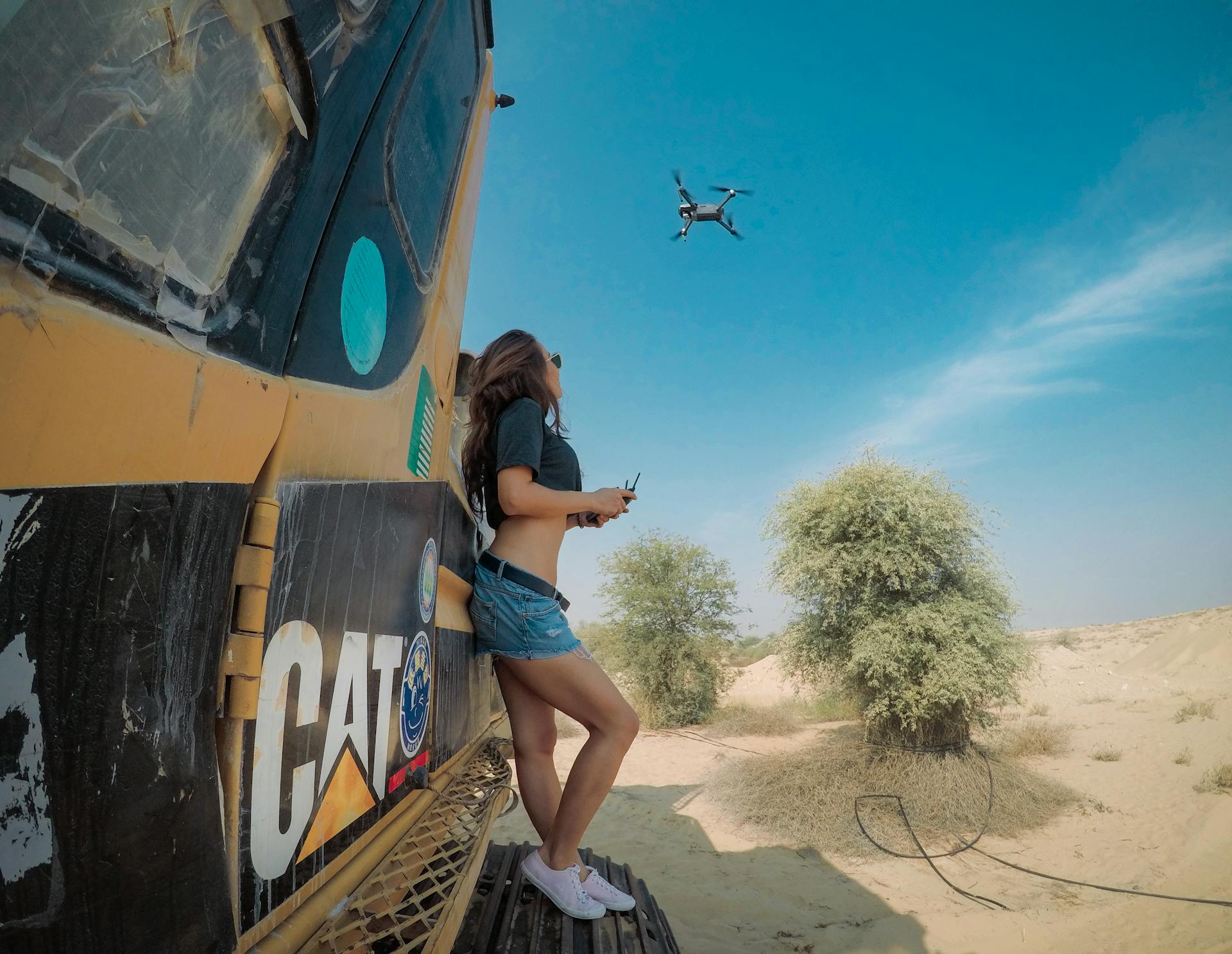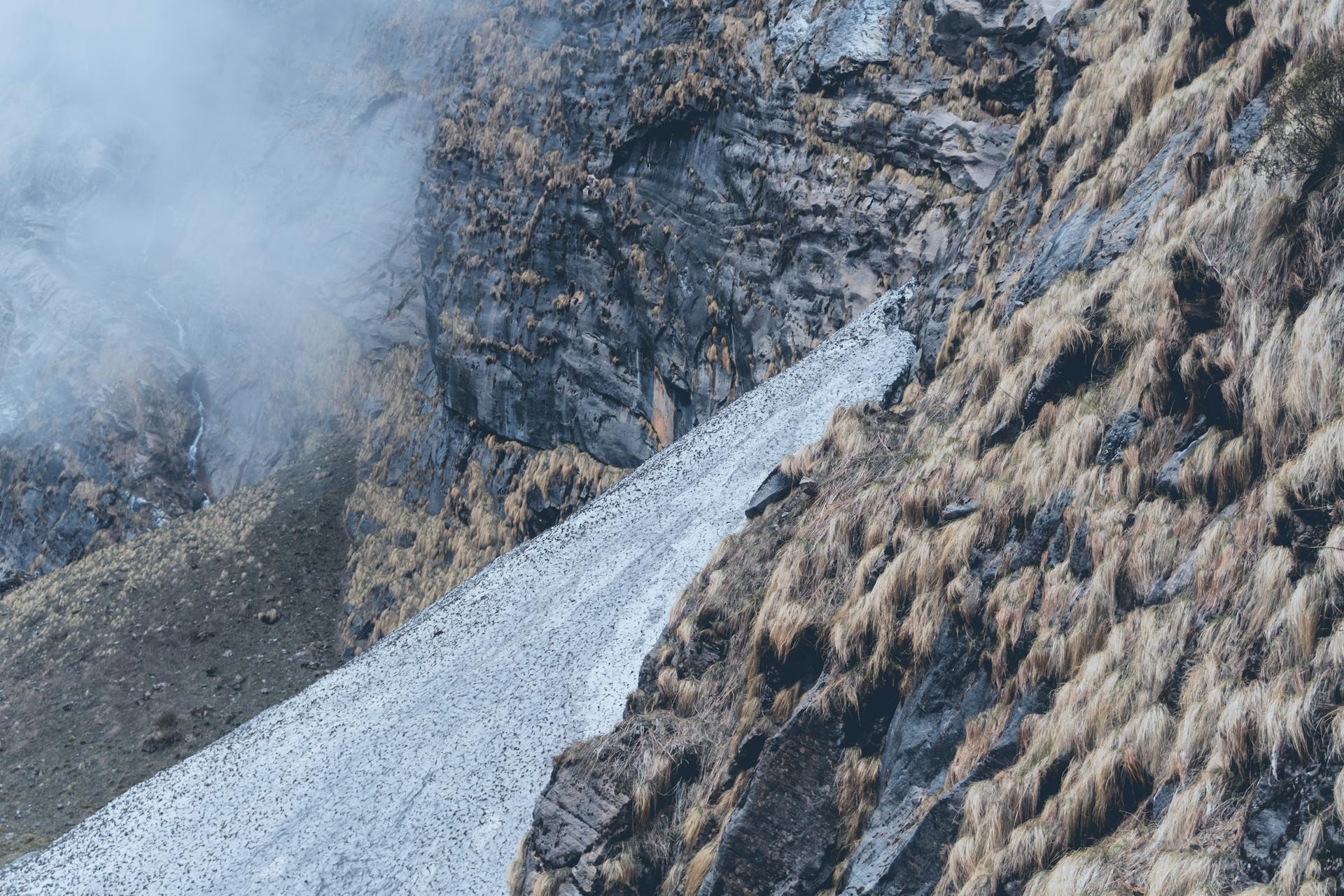
Unmanned Aerial Vehicles, or UAVs, are remotely controlled or autonomous flying devices that have been around for decades. They were initially used for military purposes, but now have a wide range of applications.
UAVs can be classified into different types, including fixed-wing, rotorcraft, and hybrid models. These classifications determine their flight capabilities and usage.
One of the key benefits of UAVs is their ability to access areas that are difficult or impossible for humans to reach. For example, they can fly over disaster zones to assess damage and provide critical information.
UAVs have become increasingly sophisticated, with some models equipped with advanced sensors and cameras that can capture high-resolution images and videos.
Take a look at this: Regulation of UAVs in the United Kingdom
Terminology and Basics
The term "drone" has been used in aviation since the early days, originally referring to remotely flown target aircraft. It's now commonly used, especially for recreational and modern applications.
A drone is an aircraft that flies without a human on board, using advanced technologies like cloud computing, computer vision, and artificial intelligence. These technologies enable drones to carry out missions autonomously.
An unmanned aerial vehicle (UAV) is a powered, aerial vehicle that doesn't carry a human operator, can fly autonomously or be piloted remotely, and can carry a payload. The US FAA defines any unmanned flying craft as a UAV, regardless of size.
UAVs can also be seen as a component of an unmanned aircraft system (UAS), which includes a ground-based controller and a system of communications with the aircraft. This emphasizes the importance of elements other than the aircraft.
The term "drone" has become widely accepted, even by government employees and industry representatives who previously shunned it.
Consider reading: Unmanned Combat Aerial Vehicle
Design and Configuration
Design and configuration are key aspects of unmanned aerial vehicle (UAV) development. UAVs can be designed in different configurations than manned aircraft because there is no need for a cockpit and its windows, and no need to optimize for human comfort.
Their design is often centered around the onboard payloads and ground equipment, giving designers greater freedom to experiment. This has led to a great variety of airframe and motor configurations in UAVs.
For conventional flight, flying wing and blended wing body configurations offer light weight combined with low drag and stealth. These configurations are popular for many use cases, including military and surveillance applications.
Check this out: Wing Delivery Drones
Product Overview
L3Harris is a leader in providing hybrid UAS systems that combine the benefits of vertical takeoff and landing with fixed-wing capabilities.
Their systems also include advanced surveillance and detect and avoid capabilities, making them a top choice for military and commercial applications.
L3Harris is working with multiple OEMs and government agencies to integrate unmanned and manned aircraft into commercial global airspace.
This integration is key to expanding the use of drones in industries such as aerial photography, environmental management, and agriculture.
Here are some key features of L3Harris' UAS systems:
Their systems are designed to meet the demands of unmanned aircraft, with advanced recorders that can store hundreds of hours of flight data and video.
L3Harris has a long history of innovation, dating back to the 1970s and 1980s when new technologies emerged that enabled the development of modern drones.
These technologies included the Global Positioning System, long-range data links, and lightweight computer equipment, which paved the way for the widespread use of drones in industries such as media, security, and agriculture.
Discover more: High Altitude Long Endurance Uav
Design
Design plays a crucial role in the creation of unmanned aerial vehicles (UAVs). UAVs can be significantly smaller than their crewed counterparts, often due to the absence of a cockpit and life support systems.
Some UAVs, like small civilian models, can be built with lighter materials and shapes, and use less robust electronic control systems. This is because they don't require the same level of safety and comfort as crewed aircraft.
The quadcopter design has become popular for small UAVs, but it's rarely used for crewed aircraft. This is because quadcopters require less-powerful propulsion technologies, such as small electric motors and batteries, which are not feasible for crewed aircraft.
UAV control systems often differ from those used in crewed aircraft. For remote human control, a camera and video link replace the cockpit windows, and radio-transmitted digital commands replace physical cockpit controls.
Autopilot software is used on both crewed and uncrewed aircraft, but with varying feature sets. This allows for more flexibility and customization in UAV design.
Here's a breakdown of some common UAV configurations:
Sensors
Sensors play a crucial role in understanding the aircraft's state. Position and movement sensors provide information about the aircraft's state.
Exteroceptive sensors deal with external information like distance measurements. Exproprioceptive sensors correlate internal and external states.
Non-cooperative sensors can detect targets autonomously, making them useful for separation assurance and collision avoidance.
Degrees of freedom (DOF) refer to the amount and quality of sensors on board. 6 DOF implies 3-axis gyroscopes and accelerometers, a typical inertial measurement unit (IMU).
9 DOF refers to an IMU plus a compass. 10 DOF adds a barometer. 11 DOF usually adds a GPS receiver.
A UAV (or UAS) can be equipped with monitoring devices such as RGB, multispectral, and hyper-spectral cameras or LiDAR. These devices may provide specific measurements or observations.
Actuators
Actuators play a crucial role in the overall design and functionality of a UAV. They're essentially the brain of the operation, controlling various components to ensure the drone operates as intended.
Digital electronic speed controllers are used to control the RPM of the motors, allowing for precise control over speed and torque. This is essential for stable flight and maneuverability.
Servomotors are commonly used in planes and helicopters, providing the necessary control and precision for these types of UAVs. They're a staple in the industry and a popular choice among drone manufacturers.
Weapons and payload actuators are also critical components, enabling the drone to perform tasks such as deployment and release. This is particularly important for military and surveillance applications.
LEDs and speakers are often used for communication and navigation purposes, providing visual and auditory cues to the pilot and other stakeholders.
Software
The software running on a UAV is called the autopilot or the flight stack. It's responsible for flying the mission autonomously or with remote-pilot input.
UAVs rely on single-board computers for their computational needs, which are designed to handle high-frequency changing sensor data in real-time. Examples of such single-board computers include Raspberry Pis and Beagleboards.
The flight stack is made up of multiple layers, each with its own specific requirements and operations. Here's a breakdown of the different layers:
This layering system allows for customization and flexibility in UAV software, enabling researchers and developers to create tailored solutions for specific applications. For example, the Technical University of Košice replaced the default control algorithm of the PX4 autopilot.
Size Estimation
To estimate the size of the UAV market, both top-down and bottom-up approaches were used.
We identified key players through secondary research, and their market ranking was determined through primary and secondary research. This involved studying annual and financial reports of top market players and conducting in-depth interviews with leaders, including CEOs, directors, and marketing executives.
All percentage shares, splits, and breakdowns were determined using secondary sources and verified through primary sources. This ensures that our data is accurate and reliable.
Market research involved accounting for all possible parameters that affect the markets covered in this study, viewing them in detail, verifying them through primary research, and analyzing them to obtain final quantitative and qualitative data.
Performance and Capabilities
UAVs can be programmed to perform aggressive maneuvers, allowing them to navigate complex environments with ease.
Flight envelope is a key aspect of UAV performance, enabling them to climb toward better communication spots after landing or perching on inclined surfaces.
Some UAVs, like VTOL designs, can control flight with varying flight modelisation, giving them greater flexibility in different situations.
UAVs can also implement perching on a flat vertical surface, expanding their capabilities and versatility.
Recommended read: Use of UAVs in Law Enforcement
Ornithopters
Ornithopters are a type of microUAV that uses flapping-wing propulsion, mimicking the flight of birds and insects.
Their inherent stealth makes them ideal for spy missions, taking advantage of their ability to fly quietly and avoid detection.
Sub-1g microUAVs, inspired by flies, have been able to land on vertical surfaces using a power tether, showcasing their agility and versatility.
Other projects have successfully mimicked the flight of beetles and other insects, demonstrating the potential of ornithopters for a range of applications.
Suggestion: UPS Flight Forward
UAV Dynamics
UAVs can be classified into five categories based on their range and endurance: very close range, close range, short range, medium range, and long range.
The very close range category has a range of less than 5 kilometers and an endurance of 0.5 to 0.75 hours.
UAVs with Wankel rotary engines have a high power-to-weight ratio, which reduces fuel usage and increases range or payload.
Proper drone cooling is essential for long-term drone endurance, as overheating and engine failure are the most common causes of drone failure.
Solar-electric UAVs have achieved flight times of several weeks, and solar-powered atmospheric satellites can potentially operate for five years.
The Boeing Condor set an endurance record with a flight time of 58 hours and 11 minutes in 1989.
Here's a list of notable UAV endurance records:
- Boeing Condor: 58:11 hours (1989)
- General Atomics Gnat: 40:00 hours (1992)
- TAM-5: 38:52 hours (2003)
- QinetiQ Zephyr Solar Electric: 54:00 hours (2007), 82:37 hours (2008), 336:22 hours (2010)
- RQ-4 Global Hawk: 33:06 hours (2008)
- QinetiQ Zephyr 7: 336:22 hours (2010)
UAVs can operate at various altitudes, including hand-held, close, NATO type, tactical, MALE, HALE, hypersonic, and orbital.
The QinetiQ Zephyr 7 set an altitude record of 70,740 feet (21,561 meters) in 2010.
Reliability
Reliability improvements in UAV systems are a top priority, using techniques like resilience engineering and fault tolerance to ensure safety and minimize cost and weight.
Individual reliability focuses on the robustness of flight controllers, which is crucial for safe flight without excessive redundancy.
Dynamic assessment of the flight envelope allows for damage-resilient UAVs, using non-linear analysis with ad hoc designed loops or neural networks.
UAV software liability is shifting towards the design and certifications of crewed avionics software.
Swarm resilience involves reconfiguring tasks given unit failures, maintaining operational capabilities and ensuring the system can adapt to unexpected events.
By incorporating these reliability improvements, UAV systems can become more robust, efficient, and safe to use, making them a valuable tool for various applications.
Consider reading: Long Endurance Uav
Aerial
Aerial photography is a breeze with drones, which can capture stunning shots in photography and cinematography. They're perfect for this purpose, and are widely used in film production.
Small drones make it easy to take on both pilot and cameraman roles, eliminating the need for precise coordination. This is a huge advantage, especially in tight spaces.
Big drones, on the other hand, usually have a drone pilot and a camera operator who controls the camera angle and lens. The AERIGON cinema drone, used in big blockbuster movies, is a great example of this.
Drones provide access to sites that would be difficult or impossible to reach otherwise, making them a valuable tool for filmmakers and photographers.
Data Transmission
Drones can amplify Internet signals and offer access to isolated locations such as deserts in Africa or Asia.
All-wireless networks in the sky are cost-effective and less troublesome, requiring lesser time to be developed than land-based networks.
Google purchased Titan Aerospace, a start-up that manufactures high-altitude drones, to support Project Loon, which delivers Internet services globally.
Data transmissions using drones can also be carried out during large-scale sports events or concerts when the coverage is insufficient for everyone in a stadium.
Control and Systems
Computer control systems have evolved significantly over time, starting with analog controls and progressing to microcontrollers, system-on-a-chip (SOC), and single-board computers. This advancement has enabled the development of sophisticated flight controllers.
Modern UAV systems rely on a primary microprocessor, a secondary or failsafe processor, and various sensors such as accelerometers, gyroscopes, magnetometers, and barometers, all integrated into a single module.
Computer Control Systems
Computer control systems have come a long way in UAVs, evolving from analog controls to modern flight controllers.
The computing capability of UAVs followed the advancements in computing technology, starting with analog controls and progressing to microcontrollers, system-on-a-chip, and single-board computers.
One common term for modern UAV-systems control hardware is the flight controller (FC), which typically incorporates a primary microprocessor, a secondary or failsafe processor, and sensors like accelerometers, gyroscopes, magnetometers, and barometers into a single module.
In 2024, EASA agreed on the first certification basis for a UAV flight controller in compliance with the ETSO-C198 for Embention's autopilot.
The certification of UAV flight control systems aims to facilitate the integration of UAVs within the airspace and the operation of drones in critical areas.
Here's a brief overview of the evolution of UAV computing capability:
- Analog controls
- Microcontrollers
- System-on-a-chip (SOC)
- Single-board computers (SBC)
Aggression
Aggression is a growing concern in the world of UAVs. Many UAVs have been loaded with dangerous payloads, including explosives and chemical hazards.

The threat of UAVs being hacked and put to malicious purposes is also a significant concern. Counter-UAV systems are being developed and deployed by states to counter this threat.
There is a big debate about the best way to counter small UAVs, whether they are used by hobbyists or in a more sinister manner by a terrorist actor. This debate highlights the complexity of the issue.
UAVs are being designed to destroy other UAVs as part of the counter-UAV systems. This shows the seriousness of the threat and the measures being taken to address it.
For another approach, see: Uav History Timeline
Counter Air System
The Counter Unmanned Air System (C-UAS) is a technology that detects and counters malicious use of Unmanned Aerial Vehicles (UAVs).
Automatic tracking and detection of UAVs from commercial cameras have become accurate thanks to deep learning based machine learning algorithms.
Commercial systems such as the Aaronia AARTOS have been installed on major international airports to detect and counter UAVs.
Once a UAV is detected, it can be countered with kinetic force, such as missiles or projectiles, or by non-kinetic force, like laser or communications jamming.
Anti-aircraft missile systems, including the Iron Dome, are being enhanced with C-UAS technologies to counter UAVs.
A smart UAV swarm can be used to counter one or more hostile UAVs.
Detect and Avoid
Detect and Avoid is a crucial aspect of unmanned air system (UAS) technology. It's a system that uses sensors and algorithms to detect and avoid collisions with other aircraft, terrain, or obstacles.
One advanced technology that's being developed is the ACAS Xu, which uses non-cooperative sensors to detect and avoid collisions. This system is integrated with directional traffic antennas and sophisticated algorithms to evaluate collision risks and execute effective maneuvers to avoid air and terrain collisions.
In fact, ACAS Xu is being used in conjunction with commercial cameras and re-identification methods to automatically detect and track UAVs. This technology is being used in major international airports, where it can be used to counter hostile UAVs with kinetic or non-kinetic force.
For more insights, see: Micro Air Vehicles
The level of autonomy in UAVs is also playing a role in detect and avoid systems. Some UAVs are equipped with autonomous operations such as altitude hold and hover/position hold, which can help them avoid collisions.
Here are some examples of autonomous operations that can help with detect and avoid:
- Altitude hold: The aircraft maintains its altitude using barometric pressure and/or GPS data.
- Hover/position hold: Keep level pitch and roll, stable yaw heading and altitude while maintaining position using GNSS or inertial sensors.
- Return-to-home: Fly back to the point of takeoff (often gaining altitude first to avoid possible intervening obstructions such as trees or buildings).
These autonomous operations can be used in conjunction with detect and avoid systems to improve the safety and effectiveness of UAVs.
Stakeholders
In the world of control and systems, there are many stakeholders who play a crucial role in the development and implementation of Unmanned Aerial Vehicles (UAVs).
UAV suppliers are the primary providers of UAVs, offering a range of models and specifications to suit different needs.
UAV component manufacturers are responsible for creating the individual parts that make up a UAV, such as engines, propellers, and sensors.
UAV manufacturers take the components and assemble them into a fully functional UAV.
Expand your knowledge: Unmanned Aircraft Systems Companies
UAV pilot training institutes provide essential training for individuals who want to operate UAVs safely and effectively.
Technology support providers offer maintenance and repair services for UAVs, ensuring they remain in good working order.
UAV software/hardware/service and solution providers offer a range of solutions to support UAV operations, including data analysis and mission planning.
Regulatory bodies establish and enforce laws and regulations governing the use of UAVs, ensuring public safety and security.
UAV consultants provide expert advice on UAV implementation and integration, helping organizations make informed decisions.
Defense forces are also stakeholders in the UAV industry, using UAVs for military operations and surveillance.
Readers also liked: Unmanned Aerial Systems Training
Frequently Asked Questions
What is the difference between a drone and a UAS?
A UAS (Unmanned Aircraft System) is a complete system that includes a drone (UAV) and the person controlling it, whereas a drone refers only to the aircraft itself. Understanding the difference between a UAS and a drone is crucial for safe and effective operation.
How many UAVs does the US have?
The US Department of Defense operates over 11,000 Unmanned Aerial Systems (UAS) for domestic and overseas missions. These UAS support various military operations and training events.
Which country invented the drone?
Israel is credited with the invention of drone technology, thanks to Abraham Karem, its founding father.
Sources
- https://en.wikipedia.org/wiki/Unmanned_aerial_vehicle
- https://consortiq.com/uas-resources/short-history-unmanned-aerial-vehicles-uavs
- https://www.l3harris.com/all-capabilities/unmanned-aerial-vehicles-and-systems-uavuas
- https://www.talonlpe.com/blog/a-brief-history-of-unmanned-aerial-vehicles-aka-drones
- https://www.marketsandmarkets.com/Market-Reports/unmanned-aerial-vehicles-uav-market-662.html
Featured Images: pexels.com


